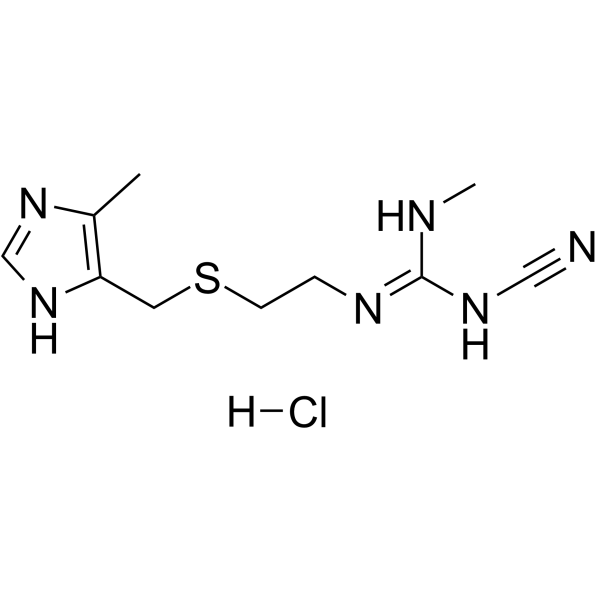Cimetidine hydrochloride

Cimetidine hydrochloride structure
|
Common Name | Cimetidine hydrochloride | ||
|---|---|---|---|---|
| CAS Number | 70059-30-2 | Molecular Weight | 288.80000 | |
| Density | N/A | Boiling Point | 488ºC at 760 mmHg | |
| Molecular Formula | C10H17ClN6S | Melting Point | N/A | |
| MSDS | Chinese USA | Flash Point | 248.9ºC | |
Use of Cimetidine hydrochlorideCimetidine (SKF-92334) hydrochloride is an orally active and inverse histamine H2 receptor antagonist with a Ki of 0.6 μM. Cimetidine hydrochloride is a gastric acid reducer, and can be used for duodenal and gastric ulcers research. Cimetidine hydrochloride has anti-cancer and anti-inflammatory activity[1][2][5]. |
| Name | cimetidine hydrochloride |
|---|---|
| Synonym | More Synonyms |
| Description | Cimetidine (SKF-92334) hydrochloride is an orally active and inverse histamine H2 receptor antagonist with a Ki of 0.6 μM. Cimetidine hydrochloride is a gastric acid reducer, and can be used for duodenal and gastric ulcers research. Cimetidine hydrochloride has anti-cancer and anti-inflammatory activity[1][2][5]. |
|---|---|
| Related Catalog | |
| Target |
H2 Receptor:0.6 μM (Kd) |
| In Vitro | Cimetidine (SKF-92334) hydrochloride, a partial agonist for H2R, has a pharmacological profile different from ranitidine and famotidine, possibly contributing to its antitumor activity on gastrointestinal cancers [1]. Cimetidine hydrochloride has no effect on the uptake and cytotoxicity of cisplatin in ovarian cancer cells with high OCT2 mRNA levels (IGROV-1 cells)[3]. Cimetidine hydrochloride shows no effect on proliferation, survival, migration and invasion of 3LL cells. Cimetidine hydrochloride reverses MDSC-mediated T-cell suppression, and improves IFN-γ production[4]. Cimetidine-mediated down-regulation of NCAM involved suppression of the nuclear translocation of NF-kappaB, a transcriptional activator of NCAM gene expression[5]. |
| In Vivo | Cimetidine (SKF-92334) hydrochloride reduces CD11b(+)Gr-1(+) myeloid derived-suppressive cell (MDSC) accumulation in spleen, blood and tumor tissue of tumor-bearing mice[4]. Cimetidine hydrochloride exerts a beneficial effect on periodontal disease in rats, decreasing the RANKL/OPG ratio in gingival connective tissue and reducing alveolar bone resorption[6]. |
| References |
| Boiling Point | 488ºC at 760 mmHg |
|---|---|
| Molecular Formula | C10H17ClN6S |
| Molecular Weight | 288.80000 |
| Flash Point | 248.9ºC |
| Exact Mass | 288.09200 |
| PSA | 114.19000 |
| LogP | 2.18118 |
CHEMICAL IDENTIFICATION
HEALTH HAZARD DATAACUTE TOXICITY DATA
MUTATION DATA
|
| RIDADR | NONH for all modes of transport |
|---|---|
| RTECS | MF0035100 |
| HS Code | 2933290090 |
| HS Code | 2933290090 |
|---|---|
| Summary | 2933290090. other compounds containing an unfused imidazole ring (whether or not hydrogenated) in the structure. VAT:17.0%. Tax rebate rate:13.0%. . MFN tariff:6.5%. General tariff:20.0% |
|
Pharmacokinetic study of hydroxypropylmethylcellulose microparticles loaded with cimetidine.
Adv. Clin. Exp. Med. 22(1) , 41-5, (2013) The objective of this study was to assess the pharmacokinetic behavior of floating hydroxypropylmethylcellulose microparticles loaded with cimetidine (FMC) prepared using the non-solvent addition coac... |
|
|
Multiple mechanisms of ligand interaction with the human organic cation transporter, OCT2.
Am. J. Physiol. Renal Physiol. 304(1) , F56-67, (2013) OCT2 is the entry step for organic cation (OC) secretion by renal proximal tubules. Although many drugs inhibit OCT2 activity, neither the mechanistic basis of their inhibition nor their transport sta... |
|
|
Inhibition of human alcohol and aldehyde dehydrogenases by cimetidine and assessment of its effects on ethanol metabolism.
Chem. Biol. Interact. 202(1-3) , 275-82, (2013) Previous studies have reported that cimetidine, an H2-receptor antagonist used to treat gastric and duodenal ulcers, can inhibit alcohol dehydrogenases (ADHs) and ethanol metabolism. Human alcohol deh... |
| EINECS 274-297-2 |
| MFCD01724314 |
| Cimetidin-HCl |
| Cimetidine Hydrochloride USP24 |
| Cimetidinhydrochlorid |
| cimetex |
| Cimetidine hydrochloride |